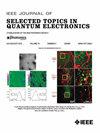Electro-Thermal Analysis of Dynamically Phase Controlled GST-Based Metasurfaces Enhanced by Graphene's Plasmonic Effect
IF 5.1
2区 工程技术
Q1 ENGINEERING, ELECTRICAL & ELECTRONIC
IEEE Journal of Selected Topics in Quantum Electronics
Pub Date : 2025-04-07
DOI:10.1109/JSTQE.2025.3558713
引用次数: 0
Abstract
The study presents a method for dynamically adjusting metasurfaces by manipulating the phase of incident light within the structure. Local heaters constructed from graphene are employed to perform this manipulation. Controlling the bias voltages applied to graphene can regulate the crystallization levels of phase-change materials, thus changing the metasurface's behavior. The plasmonic effect of graphene, which is caused by surface plasmon polaritons, is utilized to increase absorbance rates by adjusting structural parameters. The dynamic range of the proposed metasurface is achieved between石墨烯等离子体效应增强的动态相位控制gst基超表面的电热分析
提出了一种通过控制结构内入射光的相位来动态调整超表面的方法。由石墨烯构成的局部加热器用于执行此操作。控制施加在石墨烯上的偏置电压可以调节相变材料的结晶水平,从而改变超表面的行为。石墨烯的等离子体效应是由表面等离子体激元引起的,通过调整结构参数来提高吸光度。所提出的超表面在$\lambda = 1.55$ μm波长处反射波相位的动态范围在$0^\circ$ ~ $300^\circ$之间。在模拟过程中,重点考虑了影响温度和电流的4个非线性因素,即石墨烯和GST材料的电导率$\sigma (T(t))$$_{2}$ Sb $_{2}$ Te $_{5}$、GST材料在不同温度下的导热系数$\kappa (T(t))$和结晶率$L_{c}(T(t))$。由于GST材料的温度分布是不均匀的,很难均匀地预测结晶率,为了尽可能准确地模拟结晶率,本工作采用了两种场景。此外,我们展示了超表面作为光束导向和激光雷达设备的功效,强调了其在单元胞之间增强的热隔离和石墨烯等离子体效应的协同集成,以实现卓越的吸收和可重构功能。
本文章由计算机程序翻译,如有差异,请以英文原文为准。
求助全文
约1分钟内获得全文
求助全文
来源期刊

IEEE Journal of Selected Topics in Quantum Electronics
工程技术-工程:电子与电气
CiteScore
10.60
自引率
2.00%
发文量
212
审稿时长
3 months
期刊介绍:
Papers published in the IEEE Journal of Selected Topics in Quantum Electronics fall within the broad field of science and technology of quantum electronics of a device, subsystem, or system-oriented nature. Each issue is devoted to a specific topic within this broad spectrum. Announcements of the topical areas planned for future issues, along with deadlines for receipt of manuscripts, are published in this Journal and in the IEEE Journal of Quantum Electronics. Generally, the scope of manuscripts appropriate to this Journal is the same as that for the IEEE Journal of Quantum Electronics. Manuscripts are published that report original theoretical and/or experimental research results that advance the scientific and technological base of quantum electronics devices, systems, or applications. The Journal is dedicated toward publishing research results that advance the state of the art or add to the understanding of the generation, amplification, modulation, detection, waveguiding, or propagation characteristics of coherent electromagnetic radiation having sub-millimeter and shorter wavelengths. In order to be suitable for publication in this Journal, the content of manuscripts concerned with subject-related research must have a potential impact on advancing the technological base of quantum electronic devices, systems, and/or applications. Potential authors of subject-related research have the responsibility of pointing out this potential impact. System-oriented manuscripts must be concerned with systems that perform a function previously unavailable or that outperform previously established systems that did not use quantum electronic components or concepts. Tutorial and review papers are by invitation only.
 求助内容:
求助内容: 应助结果提醒方式:
应助结果提醒方式:


